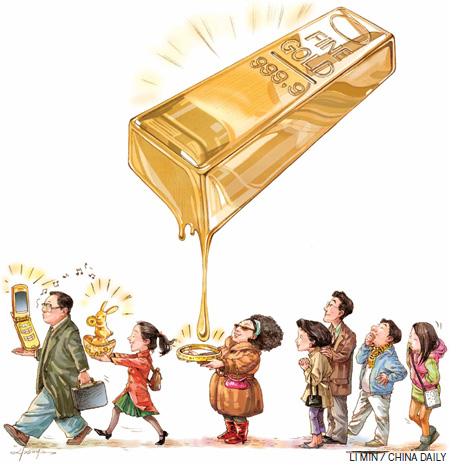Gold rush
Updated: 2011-11-04 08:53
By Alexis Hooi and Yan Yiqi (China Daily)
|
|||||||||

Bright prospects for precious metal in China as growing economic might, global financial uncertainties fuel demand
|
||||
"Counters are always swarmed with buyers, regardless of whether prices go up or down," says Caibai saleswoman Zhang Caixia.
Caibai is one of Beijing's premier locations for gold products. On Sept 25, the store lowered gold jewelry prices for the second time this year, from 432 yuan ($68, 50 euros) a gram to 419 yuan. Weeks earlier, gold prices had climbed to record highs.
Recent deals like these have helped fan a frenzy for gold among increasingly affluent Chinese buyers, as more turn to the precious metal as a form of investment amid global economic and financial uncertainty.
China now ranks second in terms of consumer demand for gold, behind India, based on latest available figures from the World Gold Council (WGC), the major market development organization for the gold industry.
Gold demand on the Chinese mainland in the second quarter of this year (Q2) alone hit 155.9 tons, worth $7.5 billion (5.5 billion euros), the WGC reports. In contrast, India's demand stood at 248.3 tons, worth $12 billion, during the same period.
In terms of gold bars and coins, Chinese buyers on the mainland actually overtook their Indian counterparts to snap up 90.9 tons of the metal in the first quarter of the year. That amount was about 5 tons more than those purchased by Indian buyers, WGC reports. But Q2 saw Chinese mainland gold bar and coin investors falling back behind buyers in India and purchasing 53 tons, about half the amount of India's 108.5 tons.
Global gold demand for Q2 was 919.8 tons and worth $44.5 billion, the second highest quarterly value on record, the WGC says. Gold prices also reached a series of record highs in Q2 and the average price for the period rose 26 percent year-on-year and increased 9 percent over the previous quarter, the council says. After peaking at $1,541 per ounce (28.35 grams) in early May, gold corrected back below $1,500 per ounce.
Despite the high prices, Chinese demand for gold grew about 25 percent in Q2 compared to the same period last year and the growth is "likely to continue due to increasing levels of economic prosperity, high levels of inflation and forthcoming key gold purchasing festivals", the WGC says. Conversely, consumer demand for gold in the United States dropped 22 percent to 44.5 tons during the same period. Europe, excluding the erstwhile Commonwealth of Independent States, dropped 48 percent to 54 tons.
China is also the world's largest gold producer and many expect it to report higher output this year, with production likely to outpace the 340 tons in 2010, figures from the Ministry of Industry and Information Technology show.
The country's gold output this year rose by 8.436 tons, or 3.87 percent year-on-year, to hit 226.388 tons from January to August, the ministry reported. In August alone, China produced 31.889 tons of gold, up from 30.08 tons in July. The combined output value of Chinese gold producers hit 169.1 billion yuan in the first eight months of the year, up 23.14 percent year-on-year.
"China, along with India, has understandably been one of the focal points in the gold market over the last decade as its share of total global demand has climbed from 6 percent in 2000 to 18 percent in 2010. The remarkable shift in the global demand balance has come about due to the combined forces of growing wealth, deregulation and increased access. It has also been propelled by heightened economic concerns that have rekindled consumer affinity for gold," says Marcus Grubb, the managing director for investments at the WGC.















